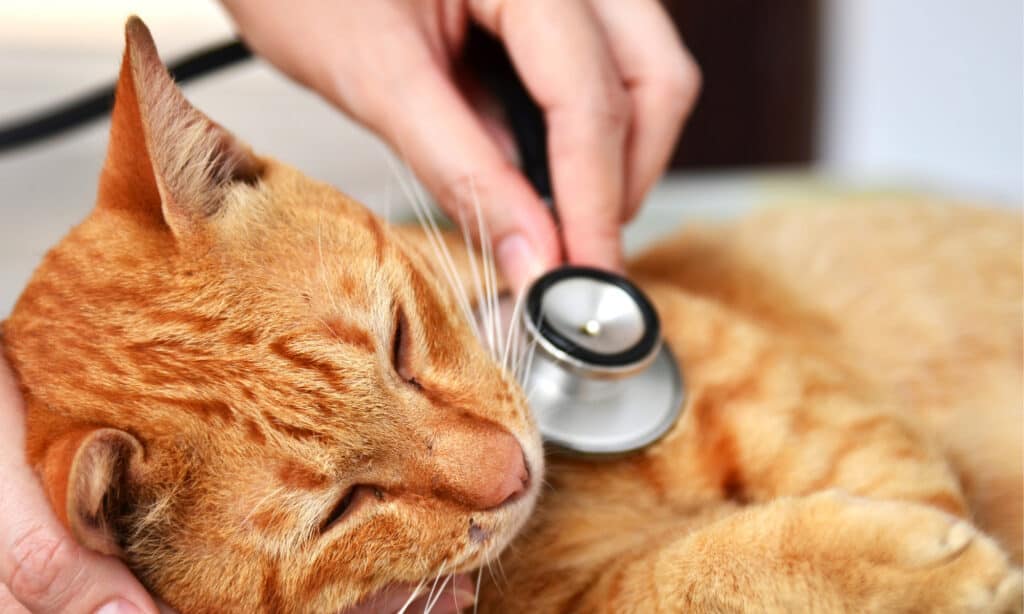Obtaining pet insurance is one of the most responsible decisions you can make as a pet parent. But if your pet has developed a health condition, you’re probably wondering if there is pet insurance that covers pre-existing conditions. Below, we explain the three main types of pre-existing conditions, share the information of some pet insurance policies that make those distinctions in their fine print (plus point you to veterinary discounts), and explain how to find the best pet insurance company for your pets.
What Is a Pre-Existing Condition?
Pre-existing conditions refer to any type of health condition that was previously diagnosed before your pet’s insurance policy takes effect. Insurance companies may look at your pet’s medical records anywhere from 12 months up to the entirety of your pet’s life to determine which health conditions are labeled as pre-existing. Although this may sound like a dealbreaker for pets that have any previously diagnosed health conditions, there are still ways to get your pet insured for accidents, other illnesses, and in some cases, those health conditions labeled as pre-existing. There are three main types of pre-existing conditions:
Genetic
Genetic conditions are typically breed-specific, and your pet insurance policy will usually cover these unless they were diagnosed prior to the date the policy takes effect. If you have a type of pet that is prone to developing specific types of genetic conditions, it’s best to get them enrolled in a pet insurance policy as soon as they become a part of your family. When your pet is young and healthy and they’re enrolled in a comprehensive policy, there are no health conditions that a pet insurance company can refuse to cover. Eventually, when your pet does develop any kind of illness (or if your pet has an accident), then all treatment will be covered based on your policy’s coverage limits.

You may be able to insure your pet even if they have a pre-exisiting condition.
©iStock.com/Jeng_Niamwhan
Curable
Some pet insurance companies may cover pre-existing conditions if they’re labeled as curable. When a pre-existing condition is curable, your pet is expected to recover and after a waiting period, that health condition may be covered under your new policy. Some examples of curable pre-existing conditions include ear infections, upper respiratory infections, and gastrointestinal problems. So long as your pet has recovered and is symptoms and treatment free, then your pet insurance policy can then fully cover the health condition.
Chronic
Chronic pre-existing conditions refer to illnesses like allergies, arthritis, skin diseases, hip dysplasia, diabetes, and cancer. These conditions are ongoing and cannot be cured. They are labeled as chronic because they affect your pets throughout their lifespan. These types of pre-existing conditions are not covered by pet insurance policies, but you may have some options when it comes to payment assistance. If you believe your pet is susceptible to developing a chronic health condition, it’s best to get him or her insured right away. If you rescue an older dog that already has these types of pre-existing conditions, pet insurance can still help cover the cost of any other illnesses or accidents. There are also payment assistance companies that can help you finance care for any health conditions that are not covered by your policy.
Can Pet Insurance Cover Pre-Existing Conditions?
If the pre-existing condition is curable, the answer is yes. However, if the pre-existing condition is chronic and it’s been diagnosed prior to the coverage date, pet insurance companies will not offer coverage. Just because you have a dog that is a specific breed and that is known to develop certain genetic conditions doesn’t mean coverage won’t be granted. If your pet has not been previously diagnosed when coverage kicks in, any tests or treatments of those illnesses or diseases are fully covered. Simply, those tests and treatments must occur after the date your policy takes effect.

The determining factor as to whether insurance will cover a pre-exisiting condition is whether it’s curable.
©iStock.com/igorr1
What Pet Insurances Cover Pre-Existing Conditions?
Now that you understand the different types of pre-existing conditions, you can see that there is a nuanced approach to pre-existing conditions. While no pet insurance company covers previously diagnosed genetic or chronic health conditions, if the pre-existing condition is curable, your pet has hope for coverage. Below, we explore some pet insurance companies that cover pre-existing conditions and approach these health conditions in an innovative way.
1. Embrace Pet Insurance
Embrace thoroughly explains how pre-existing conditions work with their policies. They confirm that they do not cover pre-existing conditions but that a pre-existing condition will never prevent you from obtaining pet insurance coverage. Ultimately, what determines whether your pet’s pre-existing condition can be covered is if it’s curable. Embrace is one of the few pet insurance companies that consider this distinction when it comes to pre-existing conditions.
Incurable pre-existing conditions will never be covered through Embrace but if your pet goes 12 months without any symptoms and without any treatment related to the pre-existing condition, then Embrace does offer coverage. Some examples of curable pre-existing conditions include vomiting, diarrhea, other gastrointestinal issues, and urinary tract/bladder infections.
So long as your pet’s medical history demonstrates that there have been no further episodes subsequent to the original diagnosis, Embrace, at their discretion, reinstates coverage for those conditions moving forward. With Embrace, you have to have a documented visit to the vet within the last 12 months before you purchase your policy. This examination is a requirement for coverage to start.
2. Pet Assure
Although Pet Assure is not a pet insurance company, it exists to help pet owners with pets that have pre-existing conditions. This is a veterinary discount plan that offers you discounts on different types of veterinary care for your pets. Since they’re not insuring you, only offering discounts, pre-existing conditions don’t matter.
Pet Assure is a simple and efficient service that’s all-inclusive so your pets can get the care they need. They don’t consider your pet’s age, any existing health conditions, or your pet’s breed. All pets can be covered under Pet Assure without any exclusions. This is like music to pet owners’ ears who have been trying to find solutions for pets with pre-existing conditions.
Along with providing discounts for any in-house treatments like spays and neuters, wellness visits, emergency care, surgical procedures, and cancer care, Pet Assure members also receive 15% off on PetCareRX, which can save you a significant amount of money over the life of your pet when it comes to purchasing required medications.
3. Pet’s Best
Pet’s Best is an insurance company that also takes the time to distinguish between curable and incurable pre-existing conditions. They explain that any illness or injury that begins prior to your policy’s effective date, even if it occurs during your waiting period, is considered pre-existing. However, they also explain that some conditions, like kennel cough or a broken leg, can heal and then require no further treatment.
When this is the case, Pet’s Best does not consider it a pre-existing condition. With a policy from Pet’s Best, you can cover your dog or your cat for accidents, illnesses, surgeries, cancer, and more. They also offer a wellness coverage plan so that you have coverage for routine care. If you require specialist care, you can also explore their specialized coverage plans as well.
What Are Bilateral Exclusions?
This is an important aspect of your policy that you should explore before confirming your purchase. Bilateral conditions refer to any pre-existing cruciate injuries on one part of their body, for example, their hips. If your pet had a pre-existing condition on the left side of his body and later developed the same condition on the right side of his body, your pet insurance policy may not cover the newly developed condition because of its relation to the pre-existing condition. However, if there is no pre-existing injury to one part of your pet’s body, and he later develops an injury or illness, then both sides will be covered.
How to Find the Best Insurance That Covers Pre-Existing Conditions
If you’re trying to insure a pet with a pre-existing condition, consider what category that pre-existing condition falls under. If it’s curable, then you have hope for coverage. Look at insurance companies’ medical history review guidelines. Embrace only goes back 12 months, meaning if your pet has not had any symptoms or treatments related to that pre-existing condition in the last year, Embrace will cover that pre-existing condition.
If your pet has a pre-existing condition that is not curable, you can still purchase a comprehensive pet insurance policy that covers accidents and any other illnesses aside from the pre-existing condition. Alongside that pet insurance policy, you can lean on Pet Assure to help you obtain discounts related to veterinary care when it comes to the treatment of the pre-existing condition.
For most pet owners, having a veterinary discount plan along with a pet insurance policy is the best route to take. This way, your pet is covered for any accidents or for the development of new illnesses and you can also obtain discounts for veterinary care. Although no pet insurance company covers incurable pre-existing conditions, you do have options for ensuring your pet gets the best care.
The photo featured at the top of this post is © iStock.com/Aleksandr Zyablitskiy
FAQs (Frequently Asked Questions)
Can you insure a dog with a pre-existing condition?
Yes, just because a dog has a pre-existing condition doesn’t mean that you cannot purchase pet insurance. A single or even a couple of different pre-existing conditions that aren’t covered by a pet insurance policy don’t prevent you from obtaining other coverage options for your pet, including accident insurance. Although you are not likely to be covered for a pre-existing condition unless it’s curable, you may still be able to get reimbursed for any other treatments related to accidents and illnesses.
Can you lie about pre-existing conditions for pet insurance?
Pet insurance companies look into your pet’s medical records for the last 12 months up to the entire life of your pet. It is not advisable to make false statements when answering questions related to your pet’s health. If you knowingly mislead your pet insurance company, you are likely to be denied claims. Plus, this is considered fraud and is grounds for your pet insurance company to cancel your policy altogether.
How does insurance know if my pet has a pre-existing condition?
Your pet insurance company does a thorough medical history review before they’re able to determine what coverages your pet may be eligible for. Aside from viewing your pet’s medical history, your pet insurance company may require that you visit a vet for a full assessment prior to approving any coverage.
Does pet insurance cover pre-existing arthritis?
Arthritis is considered a chronic health condition; therefore, pet insurance companies will not cover it. However, if your pet is symptom and treatment free for an extended period of time, you may be able to qualify for this type of coverage. Ultimately, your pet has to show signs not just of improvement but that any pre-existing condition has been cured in order to be eligible for coverage.
Thank you for reading! Have some feedback for us? Contact the AZ Animals editorial team.







